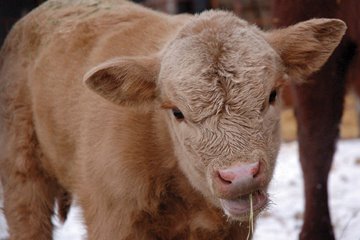Meeting the most basic nutrient requirements needed for survival should be the goal when feeding cattle following a disaster. Knowing these nutrient requirements and the types of routine and alternative feedstuffs that can meet them is important. Two scenarios are most likely during and/or following a disaster:
1) feed/hay will need to be hauled to stranded cattle; or
2) feed/hay will need to be provided to cattle that are penned. In either situation cattle will be stressed, so feeding decisions should be made with care.
Feeding Basics
Cattle should consume a minimum of 1 percent to 2 percent of their body weight per day of roughage. In general, grass or grass hay is best. Alternatives to grass hay are legume hay or pelleted or cubed roughage. Alfalfa-based hays are typically high in energy and should be fed with caution. For adult beef and dairy cattle, 20-25 lb/head/day of grass hay is best. Ideally, hay should be no less than 8 percent protein and 50 percent TDN (total digestible nutrients). If hay is of lower quality, 1 lb of a high protein supplement (20 percent to 30 percent protein) will help provide adequate nitrogen to the rumen and encourage forage intake. Calves weighing less than 500 lb. can survive on good-quality hay, but intake can be a limiting factor in meeting their requirements. Thus, 1-3 lb of an energy supplement may be useful.
Concentrate feeds should be avoided as a sole source of nutrition in emergency situations. When hay is not available, however, or when transporting large amounts of hay is not possible, concentrates may be necessary. Some concentrate feeds are less likely to cause digestive upsets than others, so careful selection of a concentrate feed can minimize problems. Some cattle may not be familiar with the concentrate supplement and will not eat, and some cattle “boss” other cattle out of the feeding area and become candidates for overeating.
Avoid corn, brewers and distillers grains and rice bran.
Acceptable concentrates for emergency feeding are soybean hull pellets, wheat middlings, hominy, corn gluten feed, beet pulp, barley and oats.
Feeding Practices to Avoid
• Abrupt changes to the diet
• Penning cattle where potentially toxic plants are available, unless adequate feedstuffs are provided
• Feeding hay or grain contaminated with chemicals or pesticides
Feeding Water-damaged Hay or Feed
Hay and feed that have been flood damaged may grow mold. Moldy hay and feeds can be toxic and usually lose most of their nutritive value. Moldy feeds may make cattle go off feed and become depressed and can occasionally cause abortions and death. Inhalation of molds can cause respiratory disease. Young animals are more susceptible than adults.
If Moldy Feeds Are the Only Option
• Test first to know levels of mycotoxins.
• Reserve moldy feeds for adult, nonpregnant, nonlactating animals.
• Dilute moldy feeds with safe feeds.
• Watch closely for signs of illness.
• Add mycotoxin-absorbing products.
Salvaging Flood-damaged Hay and Feeds
Salvaging flooded feed stores is possible, but it must be done very quickly since mold begins to grow quickly, especially in hot weather. If grain is stored in a bin, any dry grain should be removed from the top. The remaining wet grain can be ensiled, taken to a grain dryer or spread out to dry (less than 6 inches deep and stirred daily). Flooded silage should not be fed even if it looks normal.
Flooded hay may be difficult to salvage. It is also at risk of spontaneous combustion, so should be spread out to dry away from buildings. Temperature of the hay can be checked by placing a pipe deep into the middle of the bale and lowering a thermometer on string down the pipe. Take a reading after 20 minutes. If hay temperature is higher than 140 degrees, it should be removed from buildings. Bales should be moved slowly and handled gently since air contact may cause combustion.
- with permission from
Welcome to the Online Edition of Cattle Country!
Updated with every new issue
Past issues will be available in the archive. If you are interested in reading Late Breaking News between paper deadlines, scroll down to the bottom of the page. The most recent information will be posted first.
Past issues will be available in the archive. If you are interested in reading Late Breaking News between paper deadlines, scroll down to the bottom of the page. The most recent information will be posted first.

Monday, October 6, 2008
Subscribe to:
Post Comments (Atom)

No comments:
Post a Comment